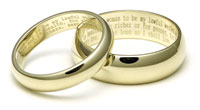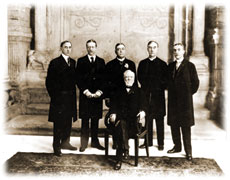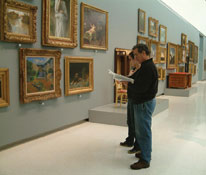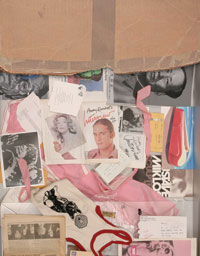|
 |
By Leslie Vincen

Banding together at
Carnegie Museums
Pittsburgh’s 250th anniversary celebration will have them crying in the aisles during the “World’s Largest Wedding Vow Renewal,” scheduled for the weekend before Valentine’s Day 2008. Announced earlier this summer, the city and Carnegie Museums are vowing to get into the “Guinness Book of World Records” by remarrying 1,000 couples in a non-denominational ceremony at Carnegie Music Hall in Oakland, one of Pittsburgh’s favorite wedding spots. Organizers plan to fly in a Guinness judge from London to oversee and ratify the event.
Attracting reunions and homecomings to the city is a primary theme of the 250th anniversary of the naming of Pittsburgh. “It’s something that comes straight out of the word ‘re-union,’” says Kitty Julian, marketing director of Carnegie Museums of Art and Natural History, who came up with the wedding idea. “Pittsburgh is all about love of family, tradition, nostalgia. ...This is exactly in that neighborhood.”
But getting to the “church” on time that day will involve more than transportation. Couples will have to pre-register this fall, and bring along their wedding certificates. The ceremony won’t be a legal, religious, or civil action, so proof of marriage is strictly for the official Guinness record-book count.
The date of the ceremony is Sunday, Feb. 10. Those wishing to join the hundreds of couples that have already said “I do” to renew their vows en masse should contact Carnegie Museums marketing assistant Leigh Kish at 412.578.2571 or kishl@carnegiemuseums.org.
In Carnegie—and his successors—we trust
 In keeping with a policy established by Andrew Carnegie 112 years ago, Carnegie Museums has always maintained a group of no more than 18 Life Trustees who serve the institution until they reach the age of 75. Four Pittsburghers have now joined those esteemed ranks as new Carnegie Museums Life Trustees: Henry J. Gailliot; Joseph C. Guyaux, President of PNC Financial Services Group, Inc.; Jane A. Kirkland, a Partner with Kirkland Partners; and Milton A. Washington, President & CEO of AHRCO. In keeping with a policy established by Andrew Carnegie 112 years ago, Carnegie Museums has always maintained a group of no more than 18 Life Trustees who serve the institution until they reach the age of 75. Four Pittsburghers have now joined those esteemed ranks as new Carnegie Museums Life Trustees: Henry J. Gailliot; Joseph C. Guyaux, President of PNC Financial Services Group, Inc.; Jane A. Kirkland, a Partner with Kirkland Partners; and Milton A. Washington, President & CEO of AHRCO.
“With such notable Pittsburgh names as Bigelow, Brashear, Magee, and Phipps, the first Carnegie Museums of Pittsburgh Board of Trustees began a great tradition of passionate support and dedicated leadership, and Andrew Carnegie had faith that the best and brightest would continue to lead this great collection of museums well beyond that original group of trustees,” says David Hillenbrand, President and CEO of Carnegie Museums of Pittsburgh. The current Life Trustees are their “direct successors,” he adds.
Carnegie Museums currently has a 73-member Board of Trustees, which includes its Term Trustees, who serve three-year terms, its Life Trustees, and its Honorary and Emeriti Trustees.
Newly elected as a Term Trustee was John C. Camillus, The Donald R. Beal Professor of Strategic Management at the University of Pittsburgh’s Katz Graduate School of Business. Elected as returning Term Trustees were Raymond T. Betler, President of Total Transit Systems, Bombardier; Jared L. Cohon, President of Carnegie Mellon University; and Alexander C. Speyer, III, Vice President of North Star Coal Company. Elected to second terms were James R. Johnson, Chairman & CEO of Russell Standard Corp.; J. Kevin McMahon, President of Pittsburgh Cultural Trust; Christine Jack Olson, Chairman & CEO of S.W. Jack Drilling Company; and Sean D.S. Sebastian, a Partner with Birchmere Ventures.
 A real ice breaker A real ice breaker
Lured by free admission and the chance to catapult snowballs into the Ohio River, more than 3,000 people visited Carnegie Science Center on June 21, causing backups as far as the
Fort Duquesne Bridge. Traffic was so heavy it encircled nearby Heinz Field in two directions.
Visitors were responding to the Science Center’s “Freezing Hot Summer” promotion, which began in February with a challenge to school children to make a snowball and save it in the freezer until the Summer Solstice, when one person would be admitted free per snowball redeemed.Most visitors toted their frozen snowballs in small coolers or freezer bags, which filled two 50-gallon trash cans and two large coolers at the Science Center’s admissions desk. Some families traveled from as far as Ohio and Washington, D.C. to participate.
The event tripled average weekday attendance to nearly 3,800 people, including 2,994 with snowballs, which were shot into the river from the USS Requin submarine with slingshots, cannons, and catapults.
Powdermill’s new human resource
 A Lancaster, Pa., kid who began his lifelong love of the natural world in the thick, scenic woodlands of Pennsylvania has come home to help preserve them. Andrew Mack, most recently a conservation zoologist and co-director of the Wildlife Conservation Society Country Program in Papua, New Guinea, was named the first of two William and Ingrid Rea Conservation Biologists at Powdermill Nature Reserve, the 2,200-acre biological field station of Carnegie Museum of Natural History. He also holds a curatorial appointment at the Museum of Natural History. A Lancaster, Pa., kid who began his lifelong love of the natural world in the thick, scenic woodlands of Pennsylvania has come home to help preserve them. Andrew Mack, most recently a conservation zoologist and co-director of the Wildlife Conservation Society Country Program in Papua, New Guinea, was named the first of two William and Ingrid Rea Conservation Biologists at Powdermill Nature Reserve, the 2,200-acre biological field station of Carnegie Museum of Natural History. He also holds a curatorial appointment at the Museum of Natural History.
Mack’s position is being funded by a generous $2 million grant from The Heinz Endowments, made in 2006 in honor of the late Bill and Ingrid Rea, two lifelong friends and supporters of Carnegie Museums and Powdermill. Through a long history of service to Carnegie Museums, the Reas made significant contributions to the areas of conservation, education, and research. Both Bill and Ingrid were very enthusiastic about seeing Powdermill evolve as a research center for a broad community of students and conservationists. The appointment of Mack perpetuates their great legacy.
Maintaining Powdermill’s 50-year history in environmental research and conservation, Mack will focus on natural conservation, including the study of natural and man-made threats to the environment—from acid rain to invasive insects. “I am delighted to be moving back to Pennsylvania,” says Mack. “At Powdermill, I hope not only to build the scientific prominence of the organization, but to help link science with practical conservation and education.”
 The gift of art The gift of art
Andrew Carnegie’s legacy of building—and maintaining—the best for Pittsburgh was suitably honored when Carnegie Museum of Art reopened its renovated Scaife Galleries in late 2003.The funding of that necessary renovation is part of the ongoing Building the Future Campaign for Carnegie Museums of Pittsburgh, and thanks to The Heinz Endowments, Carnegie Museums is $3 million closer to reaching its goal of $150 million! (See page 41 for more campaign news.) This most recent gift from The Endowments, targeted to the Scaife renovation, brings the foundation’s total Building the Future contributions to $13.2 million.
Says Janet Sarbaugh, director of Arts and Culture Programs for The Heinz Endowments, “Our most recent investment in renovations to the Museum of Art galleries is a reflection of our belief that the region’s important cultural treasures should be preserved and cared for. We want future generations of Pittsburghers to have the same access to these wonders that we’ve been fortunate to have.”
The re-imagined Scaife Galleries, home to the Museum of Art’s permanent collection, now feature 70 percent more art; more than double the exhibition space for the museum’s extensive collection of works on paper; galleries that feature stimulating floor-to-ceiling, salon-style installations; and new resource areas with comfortable seating. They also include absolute necessities: new skylights, new climate-control systems, and an infrastructure to support wireless technology.
Really thinking outside the box
 Never to be boxed in by convention or conventional thinking about art, Andy Warhol stashed thousands of pieces of his daily life into his Time Capsules. And The Andy Warhol Museum is the happy care-taker of 610 of them—cardboard boxes, or “time capsules,” as well as 40 filing cabinet drawers and one large trunk. Never to be boxed in by convention or conventional thinking about art, Andy Warhol stashed thousands of pieces of his daily life into his Time Capsules. And The Andy Warhol Museum is the happy care-taker of 610 of them—cardboard boxes, or “time capsules,” as well as 40 filing cabinet drawers and one large trunk.
To help the museum continue its quest to unpack and piece together the pieces of Warhol still in boxes, The Andy Warhol Foundation for the Visual Arts recently gave the museum a $654,000 grant to support cataloging the inventory of nearly all his Time Capsules, assembled by Warhol from 1974 until his death in 1987.
Warhol socked away photographs, newspapers and magazines, fan letters, business and personal correspondence, source images for art work, books, and objects on an almost daily basis, one box at a time, in an attempt to document his everyday life and the world in which he moved. The museum has already opened and inventoried about 100 of these boxes since its opening in 1994. For example, Time Capsule #4 contains letters received by Warhol while he was hospitalized following a 1968 assassination attempt. Other unusual items include a mummified foot, silverware he kept from a flight on Air France, a large banner created for a Rolling Stones tour, and a pair of white leather cowboy boots.
The grant will support the cataloging and preservation effort for an estimated six years. And good news, visitors: During the cataloging, you’ll get a behind-the-scenes glimpse of the process, as well as a chance to view the content of one Time Capsule at a time in the museum’s archive room.
|
 Fall 2007
Fall 2007


 In keeping with a policy established by Andrew Carnegie 112 years ago, Carnegie Museums has always maintained a group of no more than 18 Life Trustees who serve the institution until they reach the age of 75. Four Pittsburghers have now joined those esteemed ranks as new Carnegie Museums Life Trustees: Henry J. Gailliot; Joseph C. Guyaux, President of PNC Financial Services Group, Inc.; Jane A. Kirkland, a Partner with Kirkland Partners; and Milton A. Washington, President & CEO of AHRCO.
In keeping with a policy established by Andrew Carnegie 112 years ago, Carnegie Museums has always maintained a group of no more than 18 Life Trustees who serve the institution until they reach the age of 75. Four Pittsburghers have now joined those esteemed ranks as new Carnegie Museums Life Trustees: Henry J. Gailliot; Joseph C. Guyaux, President of PNC Financial Services Group, Inc.; Jane A. Kirkland, a Partner with Kirkland Partners; and Milton A. Washington, President & CEO of AHRCO.  A real ice breaker
A real ice breaker A Lancaster, Pa., kid who began his lifelong love of the natural world in the thick, scenic woodlands of Pennsylvania has come home to help preserve them. Andrew Mack, most recently a conservation zoologist and co-director of the Wildlife Conservation Society Country Program in Papua, New Guinea, was named the first of two William and Ingrid Rea Conservation Biologists at Powdermill Nature Reserve, the 2,200-acre biological field station of Carnegie Museum of Natural History. He also holds a curatorial appointment at the Museum of Natural History.
A Lancaster, Pa., kid who began his lifelong love of the natural world in the thick, scenic woodlands of Pennsylvania has come home to help preserve them. Andrew Mack, most recently a conservation zoologist and co-director of the Wildlife Conservation Society Country Program in Papua, New Guinea, was named the first of two William and Ingrid Rea Conservation Biologists at Powdermill Nature Reserve, the 2,200-acre biological field station of Carnegie Museum of Natural History. He also holds a curatorial appointment at the Museum of Natural History. The gift of art
The gift of art Never to be boxed in by convention or conventional thinking about art, Andy Warhol stashed thousands of pieces of his daily life into his Time Capsules. And The Andy Warhol Museum is the happy care-taker of 610 of them—cardboard boxes, or “time capsules,” as well as 40 filing cabinet drawers and one large trunk.
Never to be boxed in by convention or conventional thinking about art, Andy Warhol stashed thousands of pieces of his daily life into his Time Capsules. And The Andy Warhol Museum is the happy care-taker of 610 of them—cardboard boxes, or “time capsules,” as well as 40 filing cabinet drawers and one large trunk.